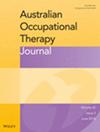Cultural safety and First Nations health content within tertiary education for undergraduate health-care students: A scoping review
Abstract
Introduction
Many health professional university programs have integrated content on First Nations health into their curricula in response to the serious health inequities between First Nations and non-First Nations peoples.
Methods
A scoping review was conducted, aiming to provide a deeper understanding of the various ways that tertiary education institutions are incorporating content on First Nations health and cultural safety into health professional education curricula, and how learning outcomes related to cultural capability are assessed.
Online databases were used to identify papers published globally between 1995 and 2021, from which 28 were selected.
Consumer and Community Involvement
First Nations co-authors, working alongside occupational therapy academics, have ensured that the meaning and context of the relevant studies have been thoroughly understood and that appropriate terminology has been used throughout the review.
Findings
There is considerable variability in the way that content on First Nations health is delivered and assessed within the tertiary sector for health-care students, internationally. There are limited assessment tools that provide a comprehensive understanding of the ability to work in a culturally safe manner with First Nations peoples.
Conclusion
The importance of having an understanding of First Nations peoples and health is recognised, with many institutions now, including this information into the university curricula as one method to positively impact the health outcomes of First Nations peoples, as well as in response to health professional accreditation and registration requirements.
There remains variability with regard to how this content is delivered and assessed. Despite encouraging data on learning outcomes, it remains unclear whether this intervention has an impact on the health-care practices of graduates once they enter the workforce. Further research into the impact of this strategy is warranted in order to determine its effectiveness.
PLAIN LANGUAGE SUMMARY
Many university programs for health professionals are recognising the importance of, including information about First Nations people in their courses, in an attempt to improve understanding and delivery of services to this population and address health inequities.
This scoping review investigated how universities teach health-care students about First Nations health and cultural safety. It also explored how students' knowledge in this area was assessed. A total of 28 papers were selected and analysed within this review.
The review found that there is great of variation in how universities teach and evaluate knowledge of this subject area. Some use a mix of online and face-to-face classes; it may be taught as a one off class or integrated throughout the entire curriculum. Activities like cultural immersion are also used.
While many studies showed that students' knowledge and attitudes improved after learning about First Nations health, it is unclear if this education affects how the students practice as health-care professionals once they graduate, and if this has any impact on the health care and outcomes for First Nations people.
Further research in this area is needed, focussing on how various teaching methods affect student learning, and how to accurately measure cultural safety. It should also consider the impact of culturally safe care on First Nations people's health and wellbeing.
This review has some limitations. It only reviewed studies published in English and did not fully explore Indigenous teaching methods, nor did it consider the impact this innovation has on future practice as a health-care professional.


 求助内容:
求助内容: 应助结果提醒方式:
应助结果提醒方式:


